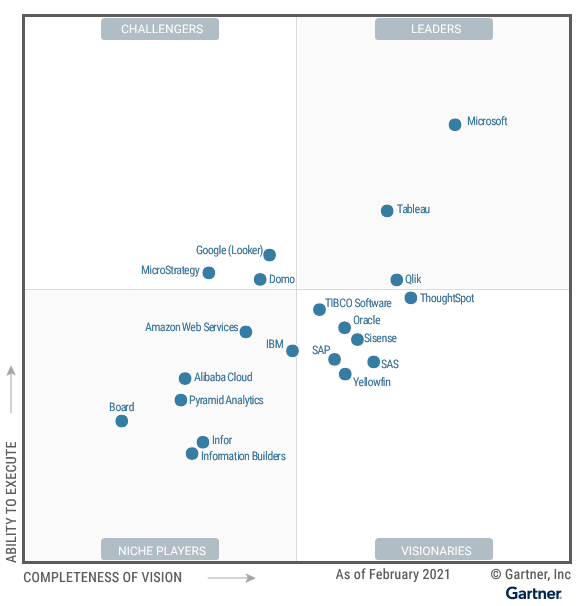Gartner Magic Quadrant 2021
Winter is almost over which means that the whole BI world is waiting for Gartner to come up with a new Magic Quadrant for Analytics and Business Intelligence Platforms report.

I always like to skim through the report to see how SAP BI is seen from a somewhat outsider view and to learn about some highlights and challenges of comparable solutions in the market.
Looking at the quadrant itself not really that much has changed since last year. Microsoft is the clear industry leader and the PowerBI guerrilla strategy of the past years (give the tool away for free and promote it from within MS Windows/Office) has definitely paid off here.
Next we have Tableau. I alway keep thinking about what could have happened if SAP acquired Tableau (instead of Roambi) a couple of years ago?
And then there is the big blob of “traditional visionairs” like Oracle, SAS and SAP.
Let’s have a look at some of the comments on SAP:
“Most companies that choose SAP Analytics Cloud already use SAP business applications.”
Yes, it is clear that SAP Analytics Cloud is almost exclusively used by SAP customers, and I also don’t really see an effort by SAP to broaden this any further. That would really be a shame and effectively bring us back in the pre-BOBJ era, where we had a similar narrow base (SAP > BW > BEx Analyzer/WAD). Problem is that nowadays the competition is way more advanced and keeps taking over a lot of the BI requirements in SAP landscapes.
“In 2020, SAP enhanced its automated insights capabilities by adding new “How has it changed?” and “How is it calculated?” explanation functionality. Also, it rearchitected the self-service user experience workflow to apply augmentation across the data-to-visualization process. Finally, enterprise reporting was updated to add scheduled publication of data stories or PDFs, although it has not achieved parity with SAP BusinessObjects’ capabilities in this area.”
The Smart Insights and Search to Insight are indeed nice concepts, but I haven’t seen much real-world use yet. The new Data Wrangling feature in SAC where you can quickly upload your data, make adjustments and immediately see the results in your story absolutely is a great improvement. I’ve always regarded the whole SAC model creation approach as too difficult and cumbersome. This at least brings us a few steps closer to what users can do in PowerBI and Tableau.
Finally about the scheduling: Some good steps have been taken, but I still need to see Excel document broadcasting next to the PDF schedules. Plus, an Analysis Office workbook repository is necessary to finally be able to step away from the SAP BusinessObjects BI Platform.
Strength: Unmatched SAP connectivity: SAP Analytics Cloud is primarily of interest to organizations that use SAP enterprise applications. Seamless connectivity to those solutions is therefore of critical importance. SAP Analytics Cloud has native connectivity to SAP S/4HANA and is embedded in SAP cloud applications, including SuccessFactors and Ariba. Further, despite being cloud-only, SAP Analytics Cloud connects directly to on-premises SAP resources (SAP BusinessObjects Universes, SAP Business Warehouse and SAP HANA) for live data, with no data replication required. Direct data connectivity to non-SAP sources still lags behind that of competitors, however.
Nothing to add here.
Strength: Differentiated augmented, closed-loop capability: SAP Analytics Cloud’s integrated functionality for planning, analysis and prediction differentiates it from almost all competing platforms. Its ability to conduct “what if?” analysis is combined in SAP Analytics Cloud with a strong, multiyear focus on augmented analytics as a core design tenet. SAP Analytics Cloud offers strong functionality for NLG, NLP and automated insights.
Yeah the integration of business intelligence, planning and augmented analytics is really what SAP could differentiate from other solutions. See my recent video on a scenario that combines these three feature areas.
Strength: Breadth of capability and content: SAP Analytics Cloud is part of a wider data portfolio that includes SAP Data Warehouse Cloud. SAP Analytics Cloud offers a library of prebuilt content that is available online. This content covers a range of industries and line-of-business functions. It includes data models, data stories and visualizations, templates for SAP Digital Boardroom agendas, and guidance on using SAP data sources.
The SAC Content Library has indeed evolved to a large collection of samples and ideas. Even 3rd party created content is widely available.
Caution: Lack of large community: SAP’s platform has less market momentum than the ABI platforms of some similarly sized vendors. Judging from public job postings, few organizations are looking to hire staff with skills in, or familiarity with, SAP Analytics Cloud, which is surprising, given the size of the BI installed base that SAP could cross-sell to. This means there is a relatively small user community for SAP Analytics Cloud, at a time when community size is a key driver for selection and adoption because technologies are only marginally differentiated.
Compared to what is happening in the Tableau and PowerBI communities, the SAP Analytics Cloud universe is still very small, although it slowly gets better looking from the increasing number of blogs and community posts. For comparison, Tableau held an online user conference with 145.000 participants in 2020. Numbers SAP can today only dream about.
Caution: Perception by potential users: Given its BusinessObjects heritage, SAP has been associated with report-centric BI, and the legacy of this is a perception among potential users that does not reflect SAP Analytics Cloud’s modern, self-service capabilities. The need to convince potential users that SAP Analytics Cloud is worth considering puts SAP at a disadvantage to the competition in selection processes.
This is true indeed. Somehow there is a perception that for example PowerBI can do stuff that is absolutely not possible in SAC (which is almost always incorrect). Also strong built-in features as the Explorer, bookmarks and the catalog are hardly known and used. Still a lot of evangelizing must be done here!
Caution:Cloud-only offering: SAP Analytics Cloud is cloud-native and not available on-premises (although it can query on-premises data). It runs in SAP data centers or public clouds (on AWS and Alibaba, with support for Microsoft Azure planned). It is currently available on data centers in China, Japan, Saudi Arabia, Singapore, United Arab Emirates, Europe, the U.S., Canada, Australia and Brazil. For organizations that want to deploy an ABI platform on-premises, SAP’s answer is to offer the SAP BusinessObjects BI platform.
Gartner puts this in as a caution year after year. It’s not really a topic anymore in my opinion. Also, the live connections towards BW and HANA work in such a way that the data doesn’t have to leave the company network.
So to wrap this up, all these comments are more or less as expected, and not that different from the quadrants of the past years. The quadrant itself also seems not to move much. For large SAP environments SAC still is a logical option because of the superior integration with HANA and BW. But, as long as SAC is still not delivering all the “basic” SAP BusinessObjects BI Platform functionality (workbook repository & scheduling), there will at least remain an opening for customers to easily consider alternatives (“Why go for SAC if I still need to keep BOBJ up and running?”). Still a lot of work to do!

